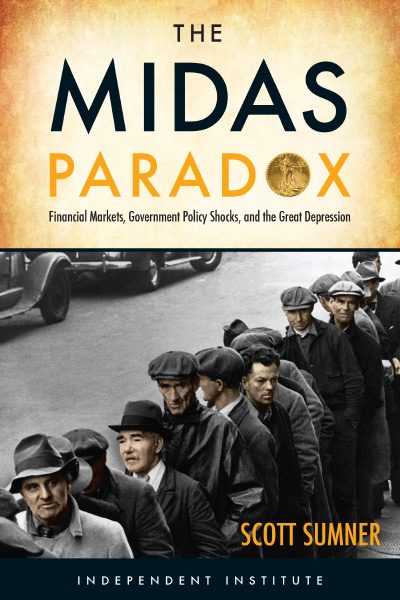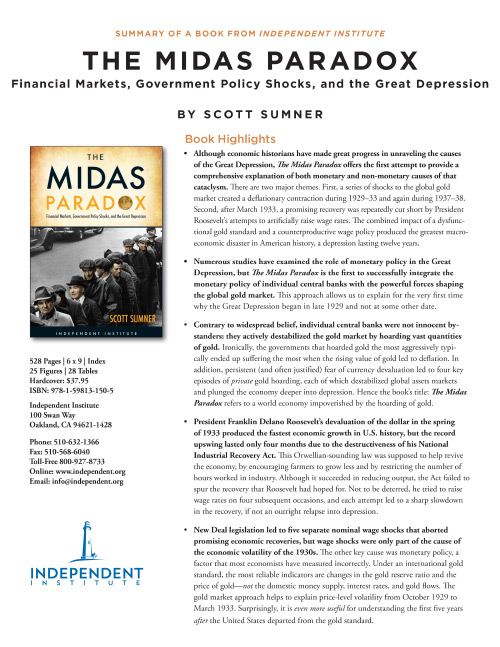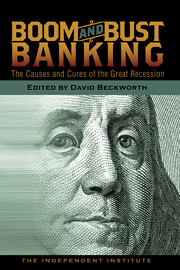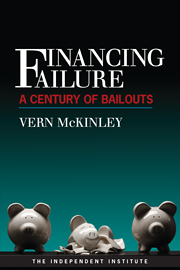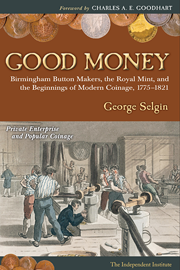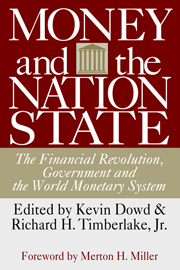| List Price: | ||
| Price: | $21.95 | |
| Discount: | $16.00 (Save 42%) |
| List Price: | ||
| Price: | $21.95 | |
| Discount: | $16.00 (Save 42%) |
Overview
Economic historians have made great progress in unraveling the causes of the Great Depression, but not until Scott Sumner came along has anyone explained the multitude of twists and turns the economy took. In The Midas Paradox: Financial Markets, Government Policy Shocks, and the Great Depression, Sumner offers his magnum opus—the first book to comprehensively explain both monetary and non-monetary causes of that cataclysm.
Drawing on financial market data and contemporaneous news stories, Sumner shows that the Great Depression is ultimately a story of incredibly bad policymaking—by central bankers, legislators, and two presidents—especially mistakes related to monetary policy and wage rates. He also shows that macroeconomic thought has long been captive to a false narrative, which continues to misguide policymakers in their quixotic quest to promote robust and sustainable economic growth.
The Midas Paradox is a landmark treatise that solves mysteries that have long perplexed economic historians and corrects misconceptions about the true causes, consequences, and cures of macroeconomic instability. Like Milton Friedman and Anna J. Schwartz’s A Monetary History of the United States, 1867–1960, it is one of those rare books destined to shape future research and debate on the subject.
Contents
Preface
Part I: Gold, Wages, and the Great Depression
1. Introduction
Part II: The Great Contraction
2. From the Wall Street Crash to the First Banking Panic
3. The German Crisis of 1931
4. The Liquidity Trap of 1932
Part III: Bold and Persistent Experimentation: Macroeconomic Policy during 1933
5. A Foolproof Plan for Reflation
6. The NIRA and the Hidden Depression
7. The Rubber Dollar
Part IV: Back on the Gold Standard
8. The Demise of the Gold Bloc
9. The Gold Panic of 1937
10. The Midas Curse and the Roosevelt Depression
Part V: Conclusion
11. The Impact of the Depression on Twentieth-Century Macroeconomics
12. What Caused the Great Depression?
13. Theoretical Issues in Modeling the Great Depression
References
Index
About the Author
Detailed Summary
- Although economic historians have made great progress in unraveling the causes of the Great Depression, The Midas Paradox offers the first attempt to provide a comprehensive explanation of both monetary and non-monetary causes of that cataclysm. There are two major themes. First, a series of shocks to the global gold market created a deflationary contraction during 1929–33 and again during 1937–38. Second, after March 1933, a promising recovery was repeatedly cut short by President Roosevelt’s attempts to artificially raise wage rates. The combined impact of a dysfunctional gold standard and a counterproductive wage policy produced the greatest macroeconomic disaster in American history, a depression lasting twelve years.
- Numerous studies have examined the role of monetary policy in the Great Depression, but The Midas Paradox is the first to successfully integrate the monetary policy of individual central banks with the powerful forces shaping the global gold market. This approach allows us to explain for the very first time why the Great Depression began in late 1929 and not at some other date.
- Contrary to widespread belief, individual central banks were not innocent bystanders: they actively destabilized the gold market by hoarding vast quantities of gold. Ironically, the governments that hoarded gold the most aggressively typically ended up suffering the most when the rising value of gold led to deflation. In addition, persistent (and often justified) fear of currency devaluation led to four key episodes of private gold hoarding, each of which destabilized global assets markets and plunged the economy deeper into depression. Hence the book’s title: The Midas Paradox refers to a world economy impoverished by the hoarding of gold.
- President Franklin Delano Roosevelt’s devaluation of the dollar in the spring of 1933 produced the fastest economic growth in U.S. history, but the record upswing lasted only four months due to the destructiveness of his National Industrial Recovery Act. This Orwellian-sounding law was supposed to help revive the economy, by encouraging farmers to grow less and by restricting the number of hours worked in industry. Although it succeeded in reducing output, the Act failed to spur the recovery that Roosevelt had hoped for. Not to be deterred, he tried to raise wage rates on four subsequent occasions, and each attempt led to a sharp slowdown in the recovery, if not an outright relapse into depression.
- New Deal legislation led to five separate nominal wage shocks that aborted promising economic recoveries, but wage shocks were only part of the cause of the economic volatility of the 1930s. The other key cause was monetary policy, a factor that most economists have measured incorrectly. Under an international gold standard, the most reliable indicators are changes in the gold reserve ratio and the price of gold—not the domestic money supply, interest rates, and gold flows. The gold market approach helps to explain price-level volatility from October 1929 to March 1933. Surprisingly, it is even more useful for understanding the first five years after the United States departed from the gold standard.
Since the early 1960s, economic historians have made great progress in explaining the causes of the Great Depression. Despite their prodigious efforts, however, none have offered a convincing account of the multitude of twists and turns the economy took from 1929 to 1940—until now.
In The Midas Paradox: Financial Markets, Government Policy Shocks, and the Great Depression, Bentley University economics professor Scott Sumner offers a novel approach to this vexing topic, one that answers previously unsolved mysteries of the 1930s by focusing on gold, wages, and financial markets. This approach enables him to explain all of the economy’s fits and starts in output, including the timing of its initial decline, something that had eluded a cogent explanation.
Drawing on financial market data and contemporaneous news stories, Sumner reveals that the Great Depression is ultimately a story of incredibly bad policymaking—by central bankers, legislators, and two presidents—especially mistakes related to monetary policy and wage rates. He also shows that macroeconomic thought has long been captive to a false narrative that continues to misguide policymakers in their quixotic quest to promote robust and sustainable economic growth.
The Midas Paradox begins with a crash course in the history of research about the Great Depression. Sumner shows that although economic historians have plowed important ground, they have left many questions unanswered because they have neglected a crucial factor: the international gold market. In Part II he utilizes a gold-market approach to deepen our understanding of the Great Contraction (1929–33), paying particular attention to the hoarding of gold by the world’s central banks. Part III focuses on monetary policy in one particularly fateful year, 1933. Part IV looks at a key consequence of dubious monetary policies: private gold holding. Part V shows how a misreading of the events of 1932–33 has profoundly distorted twentieth-century macroeconomic thought. Along with offering his conclusions, Sumner provides a technical discussion of theoretical issues related to modeling the Great Depression.
Twenty years in the making, The Midas Paradox is a landmark treatise that solves mysteries which have long perplexed economic historians and corrects misconceptions about the true causes, consequences, and cures of macroeconomic instability. Like Milton Friedman and Anna J. Schwartz’s A Monetary History of the United States, 1867–1960, it is one of those rare books that will shape all future research on the subject.
Gold, Wages, and the Great Depression
In Part I, Sumner sets the stage by examining the issues to be addressed and the strategies to be used. U.S. industrial output didn’t plunge only once during the Great Depression: it rose and fell more than a dozen times. Why was the economy so volatile? Economic historians have studied this issue for decades, but just as they have appeared to get a handle on one aspect of the puzzle, another emerges. One neglected resource for solving the puzzle—a treasure-trove of information rarely utilized in books about the Depression—is financial market data.
From 1929 to 1938, financial markets were unusually erratic and moved closely in response to news stories related to gold and/or wage legislation. The correlation is so strong that financial market data enable us to explain most of the output volatility of the 1930s. Using a simple aggregate supply and demand framework reveals that the demand shocks to the economy were triggered by gold hoarding (or changes in the price of gold), and the supply shocks were caused by policy-driven changes in hourly wage rates.
The Great Contraction, 1929–1933
Economic historians have rightly blamed banking panics and a collapse of aggregate demand for the economic decline known as the Great Contraction. Sumner, however, argues in Part II that they’ve overlooked a more fundamental factor: the surge in the demand for gold holdings. Understanding why gold hoarding soared requires that we cast our gaze afar.
Although U.S. monetary policy tightened in mid-1928, world monetary policy was stable from June 1928 to October 1929. During the twelve months that followed, however, central banks as a whole tightened sharply, and this policy switch caused (or substantially caused) a sharp drop in aggregate demand.
A key turning point in the Great Depression came in 1931. The German economic crisis and the British devaluation led to gold hoarding and a weakening of U.S. equity markets from mid-1931 to late 1932. The gold hoarding was the most important factor that depressed aggregate demand in the fall of 1931. The Federal Reserve’s increase in the discount rate in October 1931 had no impact.
Nor did the Fed’s open market purchases in the spring of 1932. Keynes suggested that this ineffectiveness might have been due to the existence of a “liquidity trap.” Friedman and Schwartz suggested that the modest upswing in late 1932 was a lagged response to the central bank’s efforts. The evidence supports neither view. The open market purchases were associated with massive gold hoarding,
a phenomenon that prevented any significant increase in the money supply. Stock prices, commodity prices, and economic output began to rise only when investors felt sufficiently confident to curtail their hoarding of gold.
Bold Experiments in Monetary Policy, 1933
In Part III, Sumner examines two of the most important policy shocks in U.S. history, both occurring in 1933. The first is Roosevelt’s dollar depreciation program. In April, at the president’s urging, the Federal Reserve took measures to raise the price level back to its 1926 level. This program, unique in U.S. history, helped cause a 57 percent surge in industrial output from March to July 1933. More precisely, the recovery resulted from the public’s expectations of future monetary expansion, not from the depreciation program alone.
The recovery was short-lived, a victim of the National Industrial Recovery Administration. In July 1933, the agency sought to sharply increase hourly wage rates—an unprecedented measure that led to a major stock market crash and helped lengthen the Great Depression by six to seven years. In a sense, there were two depressions: one related to the contraction of 1929–33 and a second, unrelated one caused by federal wage policy.
Economic historians have greatly underestimated the importance of the two policy shocks considered in isolation. Yet the importance of the dollar depreciation program can be inferred from the daily changes in the free-market price of gold, which after April 1933 became an excellent proxy for exogenous monetary shocks. The various market responses to dollar depreciation call into question many traditional theories of the monetary policy transmission mechanism.
Back on the Gold Standard
In Part IV, Sumner focuses on the level of private gold holding. Although the conventional view is that President Roosevelt took America off the gold standard, U.S. monetary policy became even more strongly linked to gold after 1934 than it had been before 1933. A recovery in the United States finally got underway when the Supreme Court declared the National Industrial Recovery Act to be unconstitutional in mid-1935. Because the demise of the gold bloc in 1936 reduced devaluation fears, its impact on gold demand and the broader macroeconomy was exactly the opposite of the British devaluation of 1931.
Actual and prospective gold dishoarding led to high inflation during late 1936 and early 1937. Expectations of future gold supplies were so high that tight monetary policies lacked credibility. Rapid inflation led to a “gold panic” in the spring of 1937 as investors worried that the buying price of gold would be reduced. During 1937, the expansionary impact of gold dishoarding began to be offset by wage increases, which reflected the resurgence of unions after the Wagner Act and Roosevelt’s landslide reelection.
Many economic historians have argued that the 1937–38 depression was caused by restrictive fiscal policy and/or by increases in reserve requirements. Neither view is persuasive. Instead, the rapid wage inflation (combined with the end of gold panic–induced price inflation) modestly slowed the economy during the summer of 1937. This slowdown led to renewed expectations of dollar devaluation during the fall, and as gold was again hoarded on a massive scale, expectations of future U.S. monetary growth declined sharply. It was this shift in expectations that triggered the precipitous declines in stock prices, commodity prices, and industrial production during late 1937.
From 1936 to 1937, commodity prices increased significantly. This boom was caused by instability in the world gold market, and was the mirror image of a more fundamental change—a sharp dip in the value of gold. Previous economic historians have overlooked the way that gold market instability triggered the boom and bust of 1936–38 and have mistakenly blamed the recession on tighter fiscal policy or higher reserve requirements. As with 1933, a complete understanding of the economy’s path during 1937 requires a subtle analysis of the interrelationship between gold market and labor market disturbances.
Gold, the Great Depression, and Macroeconomic Thought
Part V begins with Sumner’s discussion of how the misinterpretation of two key policy initiatives—the open market purchases of 1932 and the National Industrial Recovery Administration—profoundly shaped macroeconomic theory during the twentieth century. Because early Keynesian theory was based on a misreading of these policies, it could not survive the radically altered policy environment of the postwar period. By the 1980s, the original Keynesian model had been largely replaced by a (quasi-monetarist) “new Keynesianism,” featuring highly effective monetary policy and a self-correcting economy. This era may have ended in 2008.
Economic historians continue to debate whether or not the international gold standard was an important constraint for interwar central banks. It seems unlikely that this issue can ever be resolved, and the debate may have diverted attention from a much more important issue: how the world gold market affected contemporaneous policy expectations. At the deepest level, the causes of the Great Depression and World War II are fundamentally similar: both events were caused by policymakers moving unpredictably between passivity and interventionism.
The final chapter, which is geared toward Sumner’s colleagues in the economics profession, is a technical appendix on theoretical issues in modeling the gold market and analyzing real-wage cyclicality. If one defines real wages as the ratio of nominal wages and wholesale prices, then high-frequency fluctuations in real wages during the 1930s were highly correlated with movements in industrial production. Understanding real wage cyclicality is the key to understanding the Great Depression, and this requires separate analysis of nominal wage and price level shocks.
Praise
“Scott Sumner is one of the most original economists around. Having been a pioneer in making the case for nominal GDP targeting, he has now turned his insightful talents to economic history, providing an important and fresh reexamination of the causes of the Great Depression and the halting recovery thereafter. Provocative, well argued and well written, The Midas Paradox is an important contribution to our understanding of the roots of the worst economic period in the nation’s history.”
—Robert E. Litan, former Senior Fellow and Vice President for Economic Studies, The Brookings Institution
“The Midas Paradox is a must read to understand the complexities of monetary management under the international gold standards of the 1930s. Scott Sumner importantly focuses his research on the critical role of market expectations and labor policy failures that compounded central bank mistakes and led to tragic consequences for the global economy.”
—Manuel H. Johnson II, former Vice Chairman, Federal Reserve System
"Scott Sumner is one of the preeminent monetary thinkers today. The Midas Paradox represents his twenty years' study of the Great Depression, one of the most important economic events of the twentieth century. Highly recommended."
—Tyler Cowen, Holbert C. Harris Chair of Economics, George Mason University
“In The Midas Paradox, Scott Sumner provides a fascinating account of how monetary policy under the gold standard got us into the Great Depression and how wage policies under the New Deal slowed the subsequent recovery. The book is deep and rich and has important lessons for today—a must-read for anyone interested in monetary policy and history and the errors of government policy.”
—Douglas A. Irwin, Robert E. Maxwell ’23 Professor of Arts and Sciences, Department of Economics, Dartmouth College
"The Midas Paradox is first-rate scholarly work and it deserves our attention, especially as much of it applies to the recent Great Recession."
—Thomas R. Saving Distinguished Professor, Jeff Montgomery Professor, and Director of the Private Enterprise Research Center, Texas A&M University
“In The Midas Paradox, Scott Sumner adopts an ideal method (for my taste) of writing economic history. He presents plenty of details on episodes, including pending and enacted legislation, and on contemporary consensus or disagreement on explanations and recommendations. Sumner also presents judicious amounts of statistical and econometric evidence. I find all this a gripping story.”
—Leland B. Yeager, Professor Emeritus of Economics, Auburn University and University of Virginia
“Did FDR lead us out of the depths of the Great Depression, or did his policies extend it for years? Were his economic policies salutary or destructive? In The Midas Paradox, Scott Sumner answers yes. . . . Sumner makes a strong case for this story, even arguing that, without the attempt to fix wages in Washington, the Depression might have ended seven years earlier than it did. . . . Much of the book is a catalogue of catastrophic economic mistakes, and Sumner does not shrink from judging these policies harshly. . . . But Sumner is at the same time forgiving of the policymakers involved, who faced institutional, political, and even psychological constraints. . . . How can we hold the officials of the 1930s responsible for all that went wrong when we still do not have a comprehensive understanding of the Depression all these decades later? That understanding is, however, much more complete thanks to this book.”
—National Review
“With special attention to gold and labor market legislation, Sumner’s book The Midas Paradox provides an enlightening blend of detailed, warm-bodied financial and economic history of the 1930s with its broad-based statistical counterpart, using both national income accounts and financial data. His perspective will be seen as a unique contribution to the large and still growing literature on the Great Depression.”
—Roger W. Garrison, Professor Emeritus of Economics, Auburn University
“The Great Depression is the biggest puzzle in the history of modern capitalism. How could millions of people be prospering one year, then out of work the next? Building on the work of previous scholars and adding fresh insights, Scott Sumner’s book The Midas Paradox offers perhaps the most ambitious analysis of the Depression yet, which seeks to explain its major ups and downs as well as how it got started. Sumner’s book has important (and worrying) implications for today. He argues that the Great Recession of 2008-09 was so severe because economists and central banks still have not fully learned the lessons of the Depression.”
—Kurt A. Schuler, Senior Fellow, Center for Financial Stability
“Having done some recent research myself on the causes of the Great Depression, I have found Scott Sumner’s book The Midas Paradox a source of new insights on that subject. In particular, he sheds light on why deflation proved to be such an important factor in disrupting economic activity after the 1929 Crash. He makes a properly global appraisal of monetary policy and concludes that central banks, on balance, were actually tightening the money supply when they should have been easing to offset the loss of liquidity in the financial sector from the 1929 crash. The Midas Paradox is an important contribution to the study of the Great Depression, because it adds another explanation to such known factors as ill-timed protectionism of why producer prices dropped so sharply from 1929 to 1933, causing much distress in a heavily agrarian economy.”
—George Melloan, former Deputy Editor, The Wall Street Journal; author, The Great Money Binge: Spending Our Way to Socialism
"Scott Sumner's wonderful book The Midas Paradox provides a thought-provoking reinterpretation of the Great Depression: it combines a monetary approach based on shocks to the gold market with a supply-side approach based on legislated real-wage shocks that fits the evidence for the entire interwar period. Sumner's insights into the Great Depression are also highly relevant to the global financial crisis. The Midas Paradox is a major contribution both to economic history and to contemporary economic policy issues."
—Kevin Dowd, Professor of Finance and Economics at Durham University and Professor Emeritus of Financial Risk Management at the University of Nottingham, England
“Explaining the Great Depression is the ‘holy grail’ of macroeconomics, in the words of none other than Ben Bernanke. By combining economic theory with economic history and the history of economic thought, Scott Sumner shows how it is possible to make substantial progress on this ambitious project. Sumner may not explain everything, but he explains a lot. The Midas Paradox deserves a place on that short shelf of essential books on the Depression.”
—Barry J. Eichengreen, George C. Pardee and Helen N. Pardee Professor of Economics and Political Science, University of California, Berkeley
“Scott Sumner offers a unified view of the Great Depression as seen through the lens of how financial markets’ expectations of future monetary policy appeared in the price of gold especially but also in other asset markets like the stock market. In addition, the detailed, rich historical narrative is full of insights about the causal nature of policy (monetary, fiscal, and regulatory) not captured in a single, abstract model. Unlike the gold standard at the time, The Midas Paradox is not orthodox, but it certainly forces the reader to examine critically his or her prior views about the Depression.”
—Robert L. Hetzel, Staff Economist, Federal Reserve Bank of Richmond
“The Midas Paradox: Financial Markets, Government Policy Shocks, and the Great Depression is a sweeping, ambitious, and studious endeavor to fully explain both the monetary and non-monetary causes of the cataclysmic Great Depression. Author Scott Sumner (Professor of Economics, Bentley University) uses financial market data and news stories of the era to reveal that the Great Depression ultimately came from bad policymaking on all sides—the mistakes of central bankers, legislators, and two presidents all contributed toxins to the brewing disaster, particularly their errors with regard to monetary policy and wage rates. The title of The Midas Paradox refers to how the world economy was destabilized through the hoarding of gold—including both hoarding by central banks, and eventually episodes of private gold-hoarding induced by the persistent (and often justified) fears of currency devaluation. Sumner also examines wage cyclicality as a key to understanding the Great Depression, in particular the conundrum of why U.S. industrial output rose and fell more than dozen times during the Great Depression's course. The Midas Paradox is an astutely researched and presented analysis; whether one agrees or disagrees with its economic conclusions, it provides extensive grounds for examining macroeconomics from a different perspective. Highly recommended, especially for public and college library Economic Studies shelves.”
—Midwest Book Review
“Whatever you know, or think you know, about the Great Depression, The Midas Paradox will teach you something new. And as Scott Sumner points out, properly understanding what happened in the 1930s matters a great deal for getting policy right in our own time.”
—Ramesh Ponnuru, Senior Editor, National Review
“The Midas Paradox succeeds in shedding new light on the Great Depression and the gold market approach provides an effective unifying thread as the author navigates through the many shocks and policy shifts occurring over this key period. The integration of international events over this period is also the best I have seen and the connection between the 1930s policy dilemmas and those of today could not be more relevant.”
—Richard C. K. Burdekin, Jonathan B. Lovelace Professor of Economics, Claremont McKenna College
"The Midas Paradox fills a gap in our understanding of the Great Depression. The author continues the work of a long and distinguished line of scholarship that goes back to Rueff and Mundell in pinpointing the role of the gold market and the price of gold as a key factor in some of the salient episodes of the period.”
—Michael D. Bordo, Board of Governors Professor of Economics and Director of the Center for Monetary and Financial History, Rutgers University
“Think you know what caused the Great Depression? If so, be prepared to think again: The Midas Paradox bristles with well-mounted challenges to orthodox—and to many unorthodox—accounts of history’s most notorious economic crisis. Whether it manages to change your most confidently-held beliefs or not, Scott Sumner’s painstaking book is bound to improve your understanding of the deepest and longest-lasting business downturn of them all.”
—George A. Selgin, Director, Center for Monetary and Financial Alternatives, Cato Institute
“Just over 50 years ago the publication of A Monetary History of the United States, by Milton Friedman and Anna Schwartz, was a crucial episode in the monetarist counterrevolution that overturned the Keynesian dominance over postwar macroeconomics, gradually persuading most of the economics profession that the Great Depression was largely caused by the monumental ineptitude of the Federal Reserve. However, the account of the Great Depression provided by A Monetary History, its many virtues notwithstanding, was defective in a number of respects, the most important of which being that its strictly quantity-theoretic focus on the behavior of the monetary aggregates was inconsistent with the workings of the international gold standard that was in operation for much of the Great Depression. A number of subsequent researchers have since pointed out that the gold standard was a critical factor in causing and propagating the Great Depression. Now in The Midas Paradox, Scott Sumner has, with great theoretical and empirical insight and ingenuity, provided a masterly narrative account of the onset and propagation of the Great Depression and of its decade-long duration, buttressed by striking quantitative and statistical evidence of the pivotal role played by the international gold standard in the Great Depression. It is no exaggeration to say that The Midas Paradox has completely eclipsed all previous accounts of the Great Depression, and I have little doubt that a half century from now The Midas Paradox will remain the definitive account of that catastrophe.”
—David Glasner, author, Free Banking and Monetary Reform; Economist, Bureau of Economics, Federal Trade Commission
“First we had the paradox of thrift. Now Scott Sumner brings us the Midas paradox. In this book, Sumner reopens the discussion of the Great Depression—why it occurred and why it lasted so long. The book is the culmination of 30 years of work and it draws on previously unpublished data to give us a fresh look at the most important economic event in the history of the American Republic. Economists who read it won’t be disappointed. . . . The times were bleak. Between 1929 and 1933, national income was cut in half as prices and output both fell by 30 percent. One-fourth of the labor force was out of work. The newly elected president, Franklin Roosevelt, acted quickly to implement a demand-side policy change that in Sumner’s view would have ended the Depression in short order were it not completely undermined by a supply-side change that kept the economy depressed until as late as 1940. . . . In the 1920s, the common view of economists was that the business cycle was the “dance of the dollar.” The Depression gave rise to an alternative (Keynesian) view that de-emphasized the role of money. Sumner, who is often called the father of “market monetarism,” in many ways revives a classical way of looking at the world. . . . This is first-rate scholarly work and it deserves our attention, especially as much of it applies to the recent Great Recession.”
—Business Economics
“Scott Sumner has provided a tour de force of the Great Depression in The Midas Paradox. He convincingly shows in this accessible but thorough retelling of the Great Depression that policy errors were behind the long economic slump. In particular, Sumner demonstrates that the combination of contractionary monetary policy working through the gold market and supply-side disruptions arising from New Deal policies created a large drag on economic activity. This is a must read for anyone wanting to better understand the Great Depression and its implications for policy today.”
—David Beckworth, Assistant Professor of Economics, Western Kentucky University; Editor, Boom & Bust Banking: The Causes and Consequences of the Great Recession
“Scott Sumner provides a very thought-provoking and unique perspective on the causes of the Great Depression and the implications for current monetary and fiscal policy. Whether or not you agree with Sumner’s analysis, The Midas Paradox will challenge some of your beliefs and make you think.”
—John A. Allison IV, Retired President and CEO, Cato Institute; Retired Chairman and CEO, BB&T Corporation
"The Midas Paradox a fascinating, very clearly written and very important book. It sheds a new light on the root causes of the Great Depression. And, it encourages the rethinking of the fundamentals of the macroeconomic theory and policy.”
—Leszek Balcerowicz, Professor of Economics in the Department of International Comparative Studies at Warsaw School of Economics; former President of the National Bank of Poland and Deputy Prime Minister and Finance Minister of the Republic of Poland
“Scott Summer offers readers of The Midas Paradox a bountiful harvest of new nuggets about the ‘gold standard view’ of the Great Depression. This rewarding read begins with Summer’s excellent preface—an important element that allows the author to review his own book, a privilege usually denied by journals.”
—Steve H. Hanke, Professor of Applied Economics, Johns Hopkins University
“Where Scott Sumner's The Midas Paradox is most useful is in its short-interval narrative of monetary, labor market, and sometimes political factors that drove U.S. financial markets from the 1929 stock market crash through the 1937-1938 depression. His view of the impact of many New Deal initiatives is controversial, and often harsh, but well-documented. His discussion of the role of non-official hoarding and dis-hoarding of gold as a driver of liquidity conditions is original. The book will be an indispensable source for anyone on the economic dynamics of the period.”
—H. Clark Johnson, author, Gold, France, and the Great Depression, 1919-1932;former Senior Economist, U.S. Department of Defense
“The story Scott tells is really a contribution to how to conduct monetary research and economic history research. It’s a wonderful book, not only in the way that it describes what happened during the Great Depression, but because it also teaches us a new method of understanding the world. That method is ‘market monetarism’, a term I coined in a working paper in 2011 or 2010, but which Scott has embraced wholeheartedly. At the core of market monetarism is the old-style monetarism of Milton Friedman and Anna Schwartz, combined with the insight of Leland Yeager, that the demand and the supply of money is important; and that by reading what the markets are telling us we can understand that better than by purely looking at money supply numbers. . . . What economist haven’t taken much time over is the empirical study of expectations, those we can read directly from financial markets. That kind of thinking, I learned from Scott Sumner. It would be wrong to say that I learned it from reading The Midas Paradox, because I read Scott early on in the 1990s, and have known him for many years now. But it combines that thinking about money with the really deep economic and historical thinking. That’s the beauty of the book.”
—Lars Christensen, Research Associate, Stellenbosch University; Senior Lecturer, Copenhagen Business School; Denmark
“The Great Depression of the 1930s is one of the most significant events in economic history. It had an impact not only on the people who lived through it but on economic theory and policy all the way to the present. I believe there is a strong case in favor of requiring every economics graduate student to take a course on the Great Depression. Furthermore, the reading list for such a course definitely ought to include Scott Sumner's new book, The Midas Paradox: Financial Markets, Government Policy Shocks, and the Great Depression. . . . I highly recommend The Midas Paradox.”
—Arnold S. Kling, Editor, EconLog.org
“Scott Sumner’s The Midas Paradox seeks to understand the Great Depression through combining economic history, macroeconomics, and the history of economic thought into a 'seamless' whole. . . . Sumner’s conclusions contribute much to understanding what succeeded and failed during the Roosevelt Administration—which was, as concerns economic results, perhaps the most consequential US Administration during the twentieth century. . . . Sumner’s largest contribution in The Midas Paradox is in explaining why and how the depression persisted—or, as he sees it, why the US had a second, supply-side depression beginning in 1933. . . . Sumner’s account undermines a frequent view during the New Deal years, including that of Keynes in parts of the General Theory, as well as that of many populists and 'socialists' of various stripes even today, that the Depression was a consequence of unregulated financial capitalism. . . . Sumner’s discussion of the causes of the1929-1932 depression points to an important difference between that downturn and the 2007-2009 'great recession.' The earlier depression was monetary in origin; bank failures and financial crisis did not kick in until late in 1930, when they amplified demands for money and for gold relative to supplies. The 2007 downturn, in contrast, began with a financial crisis, the heart of which was widespread and often hidden exposure to low-quality mortgage debt. . . . The Midas Paradox reinforces the conclusion within the economics profession that the Great Depression was caused by monetary contraction, and that the workings of the international gold standard prevented most national economies from reflating. . . . Sumner’s data may discomfit many economists, although they will be hard-pressed to deny his conclusions. His evidence should contribute to arguments over the distributional consequences of recovery and growth in the 1930s, and perhaps more generally. . . . Sumner’s discussion of monetary and labor market factors suggests caution for prospects in 2016 and forward.”
—The Journal of Economics and Political Economy
“There have been many books written about the Great Depression, the longest and most devastating economic catastrophe in American history, but little consensus exists among scholars regarding what caused the depression, which started in 1929 and lasted until 1939. Scott Sumner, director of the Mercatus Center at George Mason University’s Program on Monetary Policy and an Independent Institute research fellow, has spent more than two decades researching the Great Depression and its causes, the result of which is his new book: The Midas Paradox: Financial Markets, Government Policy Shocks, and the Great Depression. . . . The Great Depression is surely the biggest puzzle in the history of capitalism. Millions of people were prosperous one year and out of work the next. Whatever you know or think you know about the Great Depression, this book is bound to teach you more, though you will have to be committed to learning from this serious piece of economic research. Nonetheless, the basic message is easy enough for non-specialists to understand: Gold hoarding by governments led to deflation, economic contraction, and a long-term depression. The lessons Sumner takes from his analysis of the Great Depression could have been used in managing the Great Recession of 2008, but they most certainly were not. Hopefully, such insights will come in handy when the government attempts to respond to the next economic crisis.”
—Jay H. Lehr, Science Director, Heartland Institute
“The Midas Paradox is an impressive piece of scholarship, representing the magnum opus of economist Scott Sumner. What makes the book so unique is Sumner’s use of real-time financial data and press accounts in order to explain not just broad issues—such as, ‘What caused the Great Depression?’—but to offer commentary on the precise zigs-and-zags of the economy during the 1930s. Sumner rejects the standard Friedmanite monetarist ‘long and variable lags’ approach, and argues that financial markets respond virtually instantly to new information, including announcements and events that would change expectations about the future path of monetary policy. Both because of his methodological innovations and his painstaking research, Sumner’s book is an invaluable resource to economists and historians interested in the Great Depression and the operation of the classical gold standard.”
—Quarterly Journal of Austrian Economics
“Is there anything more to say about the Great Depression? Scott Sumner thinks so. In The Midas Paradox, he offers a history of the Great Depression in the United States, with the world gold market and New Deal wage policy as the key influences. Briefly, central banks’ increasing demand for gold reserves caused severe worldwide deflation and depression from 1929 to 1932. Roosevelt's devaluation of the dollar brought rapid recovery in 1933, but the high wage policies of the New Deal kept unemployment high for the rest of the decade. These elements have featured in previous narratives. What makes The Midas Paradox distinctive is a consistent focus on the gold market, combined with close attention to high-frequency price and output movements interpreted through contemporary news accounts. Based on the efficient markets hypothesis, Sumner argues that ‘long and variable lags’ are a myth: monetary policy and other shocks should have an immediate impact on flexible-price, forward-looking financial and commodity markets. Therefore, the behaviour of stock and wholesale prices is a valuable guide to the (expected) impact of these shocks.. . . . Many of the themes of The Midas Paradox are reflected in his analysis of the global crisis following 2008, particularly the emphasis on expectations of future, as opposed to current, policy, and the power of credible monetary policy to create economic recovery despite the ‘liquidity trap’. Most provocatively, he argues that we are repeating the mistakes of the 1930s, confusing the symptoms of a collapse in aggregate demand for its causes, and failing to hold the responsible central banks to account. The Midas Paradox may not become a standard text, since it is long and requires a fair amount of background knowledge. And it is unlikely to convince readers who start out skeptical that higher wages reduce employment, that short-run speculative market fluctuations have any link to the real economy, or that bank panics are unimportant except in so far as they increase the demand for currency. But Sumner does offer a logical, plausible, and parsimonious framework for understanding the Depression, which deserves to be taken seriously by future researchers.”
—Economic Record
Five Best Books on Macroeconomics: The Midas Paradox, by Scott Sumner. Sumner tells the story of the Great Depression, probably the most important episode in macroeconomic history. Sumner believes in a monetarist interpretation of the Depression. Although I personally do not subscribe to this framework, his book provides an outstanding exposition of this important macroeconomic theory.
—EconLib
Awards
- One of 50 Books Recommended by 2017 TED Speakers
- One of The Five Best Introductory Books on Macroeconomics
News
Events
| Event | Date | |
| Research Fellow Scott Sumner, author of The Midas Paradox speaks at Prosperity Caucus in Washington, DC | Tue., Mar. 1, 2016 |

